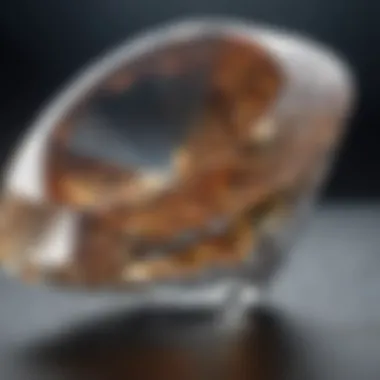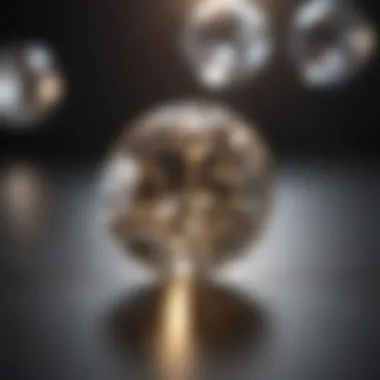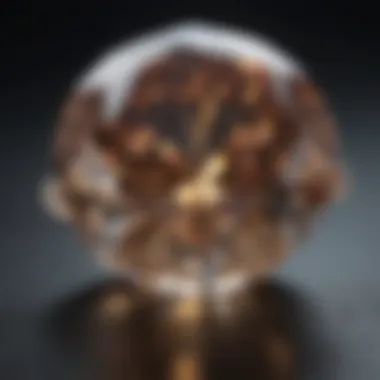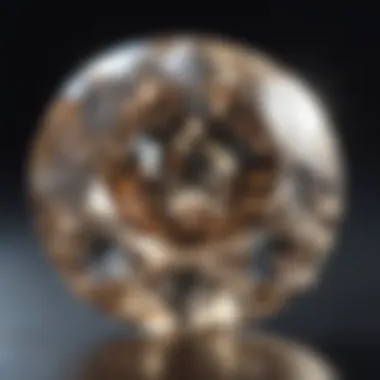Understanding I3 Diamond Clarity Ratings and Their Impact


Intro
Diamonds have long captivated human hearts and minds with their brilliance and mystique, but not every diamond shines the same way. Among the factors influencing a diamond’s allure, clarity holds distinct importance. The clarity rating can make or break a gem's value. Within this intricate classification system lies the I3 rating — a level that often raises eyebrows and questions among potential buyers. Understanding what I3 clarity entails and its implications can empower consumers to make informed choices in an often overwhelming market.
Gemstone Overview
Description of the Gemstone
Diamonds, formed deep within the Earth over millions of years, are the most coveted gemstones. They begin as carbon atoms, crystallizing under extreme heat and pressure. Traditionally recognized for their brilliant sparkle, diamonds are more than just beautiful; they represent status, commitment, and timelessness.
An I3 rated diamond falls into a category where the inclusions and flaws can significantly affect its appearance. These inclusions can take shape as dark spots or cloudiness that obstruct the stone's brilliance, making clarity assessment crucial for potential buyers. Understanding these attributes can shed light on making the right purchasing decision.
Physical Properties
The physical attributes of diamonds are impressive. They boast a high refractive index and excellent hardness, earning them the title of the hardest known natural material. Some key physical properties include:
- Crystal Structure: Cubic
- Hardness (Mohs scale): 10
- Refractive Index: 2.42
- Specific Gravity: About 3.52
Each of these properties plays a role in how a diamond appears and performs as a gemstone. The decision to purchase a diamond should not be taken lightly. Especially with an I3 rating, understanding what it means for the diamond's journey from mine to market is vital for making an educated decision.
"The true beauty of a diamond is reflected not just in its sparkle but in its clarity and character."
Understanding the I3 Clarity Rating
I3 clarity typically indicates that a diamond has significant inclusions visible to the naked eye. While these diamonds can be significantly less expensive than their clearer counterparts, buyers should keep in mind the following:
- Visual Appeal: Often, a diamond with an I3 rating will have obvious flaws that can detract from its overall visual appeal.
- Value: Generally, I3 diamonds are more affordable, making them attractive for those on a budget.
- Durability: Depending on the inclusions, an I3 diamond may be less durable due to potential weaknesses created by the flaws.
In summary, comprehending the implications of an I3 clarity rating sets a foundation for making meaningful choices during a diamond purchase.
Intro to Diamond Clarity
The world of diamonds can feel like a labyrinth. With numerous factors determining their value, clarity stands out as a crucial aspect that should never be overlooked. Understanding diamond clarity is not just about knowing the differences in visual appeal. It extends to appreciating how those differences can directly impact a diamond’s valuation and your choices in purchasing one.
When it comes to diamonds, clarity refers to the presence or absence of inclusions and blemishes. These tiny imperfections can affect the diamond's overall look, sparkle, and, ultimately, how much buyers are willing to spend. This article will particularly shine a light on I3 clarity ratings. Many potential buyers are often curious about what an I3 rating signifies and how it compares to higher ratings. Gaining insight into this grading can be beneficial for making well-informed decisions.
Key Points to Understand:
- The Basics of Clarity: Knowing what clarity means helps in navigating the diamond purchasing process.
- The Value Proposition: Clarity impacts a diamond's resale value, so understanding the implications of owning an I3 diamond can save you both time and money.
- Aesthetic Considerations: Buyers should understand how inclusions at the I3 level affect the visual qualities of a diamond.
Conversations about diamond clarity often lead to confusions and misconceptions. Some people might think that any inclusion is a deal-breaker, while others consider an I3 diamond just as valuable. Thus, it’s essential to dissect the details surrounding clarity ratings, particularly focusing on I3. The financial investment, emotional attachment, and commitment of time mean that being well-informed is not just beneficial—it's necessary. Therefore, understanding this critical aspect of diamonds will empower you to navigate these waters with greater confidence.
Understanding Clarity Ratings


Understanding clarity ratings is crucial when it comes to appreciating diamonds. Clarity refers to the presence of inclusions and blemishes that can detract from a diamond’s beauty. A well-informed buyer can navigate the complexities of these ratings, ensuring they make a sound investment. Clarity affects not only a gemstone’s visual appeal but also its value in the market.
When considering clarity, one must look beyond the numbers. Inclusions can interfere with light permeability, thus impacting a diamond's sparkle. Knowing how to interpret these ratings provides a clearer perspective on what to expect from different classifications. Moreover, a deeper understanding can pave the way for more cost-effective purchasing, especially when one discerns the nuances between seemingly minor variations in clarity.
The GIA Clarity Scale Explained
The Gemological Institute of America (GIA) developed a clarity grading system that categorizes diamonds into several distinct levels. This scale ranges from Flawless (FL), which shows no inclusions visible at 10x magnification, to Included (I), where inclusions are apparent to the naked eye. The scale typically includes:
- Flawless (FL)
- Internally Flawless (IF)
- Very Very Slightly Included (VVS1 and VVS2)
- Very Slightly Included (VS1 and VS2)
- Slightly Included (SI1 and SI2)
- Included (I1, I2, and I3)
This hierarchy is vital as it helps potential buyers differentiate between diamonds not just by appearance but also by their inherent quality. An I3 rating indicates significant inclusions, often making it less desirable for many. A significant aspect of the GIA scale is its standardized approach, making it easier for buyers to understand the quality of what they are purchasing.
Overview of Clarity Grades
Clarity grades serve as a crucial guideline in the diamond industry, providing potential buyers insight into the uniqueness of each stone. While many may think clarity is a straightforward measure, it comprises various factors, including the number, size, and position of inclusions.
The grading itself can be boiled down to several essential components:
- Visibility: How easy are inclusions to see?
- Size: Are the flaws microscopic or large enough to notice?
- Number: Is there a single inclusions or several?
- Location: Where in the diamond are these inclusions positioned?
A diamond with a higher clarity grade will generally command a higher price, but not all buyers place equal value on clarity. Some may prefer the character that comes with minor blemishes, while others see clarity as paramount.
In closing, understanding clarity ratings isn't merely about knowing whether a diamond is flawless. It’s about comprehending the full narrative each stone tells, which includes a range of aesthetic and intrinsic qualities that influence market dynamics.
Deep Dive into I3 Clarity
Exploring the nuances of I3 clarity ratings is vital for anyone stepping into the diamond market. This exploration is not just about understanding the grading system; it’s about uncovering its implications for buyers and sellers alike. When we dig into I3 clarity, we unveil a world where the visual presence of inclusions poses both challenges and opportunities for those interested in diamonds.
What Does I3 Mean?
I3 indicates the lowest clarity grade on the GIA scale, suggesting significant inclusions and imperfections visible to the naked eye. In layman's terms, if you encounter an I3 diamond, expect that these blemishes will stand out like a sore thumb. What makes I3 particularly interesting is the contrast it presents against its higher-rated counterparts. Buyers need to comprehend that, while I3 diamonds may be financially accessible, they come with their own set of complications for both visual appeal and functionality.
Understanding I3 clarity is essential because it sets realistic expectations. When diving into this rating, it becomes clear that these diamonds may not sparkle the way one hopes, yet their affordability may open doors to unique opportunities for budget-constrained shoppers.
Characteristics of I3 Diamonds
Visibility of Inclusions
The visibility of inclusions in I3 diamonds significantly impacts their overall appeal. Inclusions can range from tiny specks of carbon to larger fractures that drastically affect the look of the stone. Typically, these inclusions are easily noticed by someone simply glancing at the diamond.
This is a double-edged sword. On one hand, buyers get a diamond with a lower price tag, making it a tempting pick for those looking to save money. On the other hand, the beauty that diamonds traditionally offer may be compromised.
Impact on Optical Performance


Optical performance holds a crucial role in any diamond's allure. I3 diamonds often face hurdles here due to the numerous inclusions that can distort light. A diamond’s ability to reflect and refract light beautifully is what makes it a symbol of elegance. Sadly, in I3 diamonds, you might find that brilliance takes a backseat to the visibility of flaws. While the optical qualities are not entirely ruined, one must be prepared for a more subdued sparkle. Consequently, these diamonds may not be ideal choices for engagement rings or other significant pieces.
Durability Considerations
Durability is yet another significant aspect associated with I3 clarity ratings. Inclusions can not only affect a diamond’s beauty but may also weaken its structure. Larger flaws can increase the chance of chips or breaks over time. Though diamonds are hard, an I3 diamond's integrity may be less reliable than its clearer counterparts. These diamonds are also prone to scratching due to their internal imperfections. Thus, a buyer should consider how often the diamond will be worn and in what settings it might experience wear and tear.
"I3 diamonds can be a versatile choice for those who understand their potential yet are prepared for the trade-offs that come with them."
In summary, knowing the ins and outs of I3 diamonds allows buyers to make informed decisions. The visibility of inclusions, the impact on how light dances within, and the considerations around durability all factor into whether an I3 clarity rating is a suitable choice.
Grasping these characteristics enables both enthusiasts and buyers to appreciate what I3 diamonds bring to the table, helping them align their purchases with personal priorities and expectations.
Comparative Analysis of Clarity Ratings
When it comes to diamonds, clarity ratings play a pivotal role in how they are perceived in the market. This section sheds light on the implications of the clarity ratings, especially focusing on I3 diamonds. By understanding how I3 compares to higher ratings, buyers can make educated choices that align with their preferences and financial expectations.
Comparing I3 with Higher Ratings
Difference with I1 and I2
The differences between I3 and the higher clarity ratings, such as I1 and I2, are quite apparent, and understanding these distinctions help buyers grasp exactly what they are getting into. An I1 clarity rating signifies that inclusions are noticeable but not easily visible to the untrained eye. In contrast, I2 indicates that the inclusions are more obvious, yet they still might not affect a diamond's brilliance in a significant way.
On the other hand, I3 diamonds have inclusions that are distinctly visible and can heavily impact their appearance. This means that when weighing the options, an I1 or I2 rated diamond could be more favorable if clarity is a priority. Thus, the key characteristic here is visibility; the clearer gemstones are often more desirable in jewelry markets.
The beneficial choice for many buyers lies in selecting diamonds from the I1 or I2 ratings due to their higher visual appeal. However, an I3 diamond may possess its own set of advantages, particularly in terms of cost. Lower clarity often means lower prices.
Advantages of Higher Clarity Grades
When discussing the advantages of higher clarity grades, it’s essential to mention not only aesthetic beauty but also overall investment value. High clarity diamonds, which could range from IF (Internally Flawless) to VVS (Very Very Slightly Included), offer the key advantage of maximizing a diamond’s sparkle and visual appeal. The clarity characteristics are so low that they generally remain invisible without magnification, which appeals to many buyers eager for a flawless appearance.
Moreover, the overall unique feature of higher clarity diamonds is their strength in the market. These diamonds often endure better in resale scenarios, fetching better prices later on. In contrast, an I3 diamond, while more affordable, may struggle with resale value due to visible inclusions impacting desirability. This consideration is paramount when deciding which diamond to invest in.
Market Perception of I3 Diamonds
I3 diamonds bring a layer of complexity to the diamond marketplace. While they are often viewed skeptically, they do hold their own unique market segment. The perception of I3 diamonds can vary significantly; some buyers simply see them as suitable for budget-friendly options, while others may undervalue them entirely due to the visible inclusions.
In many cases, those who are not overly concerned with the aesthetics might see I3 diamonds as functional gems that still serve their purposes. For engagements or other special occasions, some might prioritize the sentiment over the clarity. In this light, I3 diamonds can actually appeal to a niche audience looking for affordability amidst the sparkling allure of the diamond market.
Ultimately, understanding the comparative elements of clarity ratings empowers buyers with knowledge and clarity—allowing them make informed decisions that fit their tastes and expectations.
Practical Implications for Buyers
When it comes to purchasing diamonds, understanding clarity, especially the implications of an I3 rating, is vital for various reasons. This section dives deep into why buyers should take these factors seriously and what they mean for their purchase decisions.


Diamonds are often seen as a symbol of love and commitment, but not every diamond holds the same value, especially if its clarity is categorized as I3. Buyers need to approach the decision with a clear mind, weighing the pros and cons of such a rating.
Is I3 Worth Buying?
Whether an I3 diamond is worth the investment can really depend on one's personal taste and financial situation. For those just starting on their jewelry journey, an I3 diamond might be appealing due to its generally lower price point. However, the visual quality can be significantly impaired. Inclusions are visible to the naked eye, diminishing the brilliance and fire that many look for in a diamond. If you're planning to buy for special occasions, it might be worth considering a higher clarity grade to ensure that the diamond sparkles as required. An I3 diamond could be suitable for someone who values size over clarity or who simply wants this stone as an art piece rather than an engagement display.
How to Assess an I3 Diamond
Evaluating an I3 diamond requires careful consideration to determine if it meets your expectations. Here are aspects to look into:
Evaluating Visual Appearance
Visual appearance is crucial when it comes to diamonds. In the case of I3 diamonds, the appearance might be marked down due to conspicuous inclusions and potential color issues. Inclusions can resemble dark spots or cloudiness which can distract from the overall aesthetic.
This aspect is often subjective—some buyers may not mind visible flaws, while others can't stand them. It's beneficial to see it in person or through detailed photographs. One significant characteristic of visual appearance is its impact on durability and the chance of future wear. If a diamond appears less appealing, potential purchasers may shy away when it comes to future resale.
Viewing Conditions and Lighting
Just as crucial as the diamond's appearance is the context in which you view it. Diamonds can look quite different under various lighting situations. An I3 diamond might seem more appealing in dim light, where inclusions aren’t as noticeable.
Knowing the lighting conditions is key to a good assessment. Bright, natural light can reveal flaws swiftly, highlighting the less desirable characteristics of an I3 diamond. Therefore, always pick different environments to evaluate how the diamond reflects different types of light. This dual approach allows for a comprehensive understanding of real-world appearance.
An I3 diamond may be a budget-friendly choice, but understanding its characteristics is essential to making an informed decision.
By keeping these points in mind, you can make an understanding decision about investing in an I3 rated diamond. It all circles back to individual priorities. Whether you want a statement piece or a subtle memento, weighing these aspects can guide your diamond purchase journey.
Long-term Considerations
When contemplating the purchase of an I3 diamond, it becomes essential to evaluate the long-term ramifications of this clarity rating. The implications span across maintenance and potential resale value, which can significantly influence one’s investment in these gems. I3 diamonds may appeal to buyers due to their affordability; however, understanding their upkeep and future worth is crucial for making a sound investment decision.
Maintenance of I3 Diamonds
Caring for an I3 diamond requires a bit of diligence. Often, the inclusions and blemishes in such diamonds might compromise their durability and brilliance over time. Here are some effective maintenance tips to consider:
- Regular Cleaning: To maintain optimal sparkle, it's vital to clean the diamond regularly. Utilize a mild soap solution and a soft-bristle toothbrush to gently scrub any dirt or oil buildup. A professional jeweler can provide deep cleaning to restore its shine.
- Safe Storage: When not adorning your piece, store it in a soft pouch or a compartment that prevents scratching against other jewelry. Ideally, keep it away from direct sunlight to reduce any potential fading of its luster.
- Inspection: Schedule routine inspections with a jeweler to evaluate the integrity of the stone. Inclusions can sometimes impact the structural stability, so ensuring that the diamond remains secure in its setting is paramount.
By investing time in maintenance, one can significantly enhance the longevity of an I3 diamond, allowing it to retain its allure longer than one might expect.
Resale Value Insights
Selling an I3 diamond down the line may not yield the returns seen with higher clarity ratings, yet understanding this aspect provides clarity for potential buyers. The factors influencing resale value include:
- Market Demand: The demand for lower clarity diamonds fluctuates and is often dictated by current trends and economic conditions. While I3 diamonds can be found at lower price points, they may not evoke the same enthusiasm as their clearer counterparts.
- Condition at Sale: The condition of the diamond plays a significant role. If it’s well-maintained, with minimal signs of wear, its resale potential improves, even if its clarity rating doesn’t turn heads.
- Proof of Authenticity: Having documentation that confirms the diamond's clarity grading can positively influence resale value. Buyers appreciate transparency and may be more inclined to invest if proper certifications are in place.
End
Drawing to a close, the topic of diamond clarity—specifically the implications of an I3 rating—stands as a beacon of understanding for both buyers and enthusiasts alike. Navigating the landscape of diamond purchasing can be quite daunting; hence, grasping the nuances behind clarity ratings is crucial. Diamonds rated as I3, marked by a notable number of inclusions and flaws, may not hold the same allure as their higher-graded counterparts. However, these diamonds carry their own set of considerations that can be valuable for certain buyers.
Firstly, it is vital to realize that clarity does not exist in a vacuum. It interacts dynamically with several factors, including cut, color, and carat weight. An I3 diamond can, in some cases, still appeal to buyers on a budget or those seeking a more unique diamond experience. Educating oneself about the visibility and type of inclusions present in I3 stones can reveal whether their aesthetic diminishes the overall beauty.
Moreover, there's a certain charm that I3 diamonds might offer in terms of individuality and character, steering a buyer toward a one-of-a-kind option. Their lower price points can also foster a pathway to exploring larger stones or different settings. Often, value is perceived through a broader lens that encompasses personal stories and connections rather than merely technical specifications.







